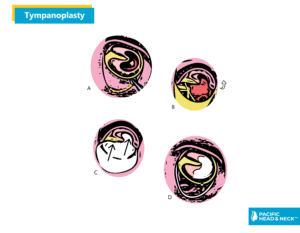The ear drum (also known as the tympanic membrane) is an oval shaped structure, with an average size of 8x10 millimeters, and is composed of three layers. The outer layer consists of a thin layer of skin, the middle layer is made of fibrous tissue and the inner layer is mucosa (similar to the tissue in the mouth and nose). The tympanic membrane is secured to the sidewalls of the end of the outer ear canal by a thick band of tissue called the tympanic ring or annulus. This ring helps in the overall structural integrity and stability of the eardrum. The integrity of the tympanic membrane and associated structures is important for proper sound conduction.
When a hole is created in the eardrum, it usually heals on its own. When the hole does not heal, it can cause hearing loss and repeated ear infections. Pacific Head & Neck has minimally invasive techniques to repair eardrums in both children and adults.

Diagnosis
There are different types of tympanoplasty, some tests may consist of:
- A microscopic exam
- Audiogram of the hearing loss
- History of hearing loss
- Vertigo or facial test









